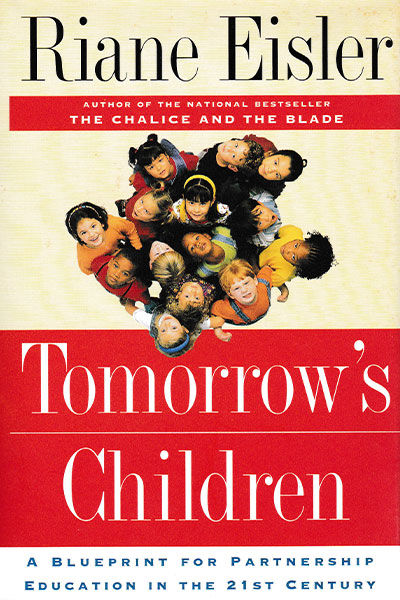Humanities taught from a partnership perspective is more multicultural, gender-balanced, and focused on issues of human rights and responsibilities.
Literature and the humanities are usually taught together in high school, although they are often separated in the university curriculum. In universities, humanities typically include subjects such as philosophy, mythology, theatre, literature and film as well as languages. As generally taught, the study of humanities chronicles the thinking of Western philosophers probing universal questions about our cosmos and our species. This offers valuable ideas, and sometimes remarkable pyrotechnics of the mind. (See Richard Tarnas, The Passion of the Western Mind.) But it is a limited and problem-laden approach.
To begin with, it is strange to speak of humanities when what is taught under this rubric has basically excluded most non-Western cultures. The term humanities seems even stranger when we consider that what is taught under this heading has been almost exclusively men writing about men ? that it has excluded no less than half of humanity: women. Moreover, some of what is included under this description of humanities has contributed to a great deal of inhumanity.
For example, Aristotle’s philosophical writings assert that slaves and women ?naturally? belong in a subservient place, and even that women are deficient, mutilated males. The philosopher Nietzsche (whose works are a mainstay of the humanities curriculum, and who is greatly admired in many texts) asserts that there is a superior master race of men entitled to dominate other men (and all women) ? a philosophy that provided inspiration for Hitler’s propaganda of Aryan racial superiority, which cost many millions of lives and justified the most hideous cruelty and inhumanity.
So what can properly be called humanities? If we look at this question through the lens of the partnership and dominator continuum, we come to the basic issue of what in the conventional humanities curriculum helps us better understand ourselves and one another, and what smuggles inhuman and antihuman messages into our minds.
What really do we learn from ?classics? such as Homer’s Iliad and the novels of Hemingway about ?nobility? and ?heroism?? What do such works teach us about human relations? The Iliad begins with an argument between the hero Achilles and the King Agamemnon about a ?prize of war? ? a young woman captured by the Greeks, whom the soldiers have awarded to the hero Achilles but whom Agamemnon covets. Nowhere in this work is there any mention that this young woman, Briseis, another human being, is treated as mere property. Nowhere are her feelings, her needs, her wishes, or for that matter her suffering, even considered. She is no more than an object, a slave, to be sexually used by either Agamemnon or Achilles. The real issue, and dilemma, presented to us by Homer is which of two men ? the king or the hero ? is ?rightfully? entitled to this ?prize.?
The study of humanities from a partnership perspective can begin, as many courses already do, with The Iliad, followed by an invitation to students to think about what can properly be considered humanities.
- What cultivates in us our human capacity for empathy, rather than deadening it?
- What are major cultural contributions?
- Is The Iliad, which celebrates killing as heroic, such a contribution?
- Or should it be studied primarily from a historical perspective as a well-written work that tells us of a time when domination and conquest were the most valued of ?manly? pursuits?
Using the templates of the partnership and dominator models, students can evaluate what normative messages ?great books,? ?great philosophers,? and ?great classics? have taught us to accept as normal and moral. Partnership elements can be found in many of these works, of course. But these beautifully written texts also often idealize prejudice and cruelty, conditioning us to emotionally accept such feelings and behaviors. And they rarely offer models for healthy, fulfilling, nonviolent ways of living.
Contributions by Women and People of Color
Through the study of humanities from a partnership perspective, students will also become aware of the important contributions made by women and nonwhite men. There is already growing awareness that for the vast majority of American children (all girls, plus both boys and girls who are of African, Hispanic, Native American, or Asian descent) it is disempowering that the people presented to them as having made significant contributions to human culture at best only occasionally include anyone like them. Students can be invited to look at why this is so, despite the fact that both women and men of all races and ethnic origins have made major contributions.
Studying humanities from a partnership perspective incorporates multicultural materials.
- For example, the works of W.E.B. DuBois, Cornell West, and Darlene Clark Hine provide important African-American perspectives on politics and race relations.
- The works of the Latin American philosopher Paolo, particularly his Pedagogy of the Oppressed and the writings of the Italian educator Maria Montessori are important contributions to education and the humanities.
- So also are writings by and about Gandhi as a philosopher and leader in the struggle for social and economic justice.
Humanities from a partnership perspective is also more gender-balanced.
- For instance, Gandhi’s nonviolent tactics paralleled the nonviolent tactics of 19th and 20th century feminists struggling to gain the vote for women in England and the United States when Gandhi began his struggle to free India from British colonial rule.
- The works of 18th and 19th century feminist philosophers such as Mary Wollstonecraft and Elizabeth Cady Stanton, and of 20th century feminist philosophers, such as Charlotte Perkins Gilman, Gloria Steinem, and bell hooks, merit inclusion in the humanities.
- So also do ecofeminist writing such as those of Vandana Shiva and Susan Griffin, which emphasize a link between the rape of women and of nature.
- The contribution of women to a reconceptualization of human rights that includes women’s rights and children’s rights (the majority of the human population) is also an important topic in the study of the humanities.
Human Rights
The study of the humanities in today’s schools should focus on issues of human rights and responsibilities relevant to our time. It is essential that students become acquainted with United Nations’ documents that blueprint a more humane future. Regardless of conflicting opinions about the United Nations’ efficiency, these documents are important building blocks for a partnership world. Examples are the 1948 ?Universal Declaration of Human Rights,? ?The Convention on the Elimination of All Forms of Discrimination Against Women,? and ?The Convention on the Rights of Child.? There are also important United Nations conventions on the environment, population, and development that young people need to look at. Indeed, the contemporary discourse about morality, which so often focuses on punishing and persecuting anyone considered a deviant, urgently needs to be reframed in terms of respect for human rights and our responsibility to create a more just and nonviolent society.
The study of the humanities particularly needs to highlight the long-neglected cultural contributions of the female half of humanity. By this I mean not only how even in periods when women have been generally confined to “helpmate” roles as wives, mothers, domestic servants, or nannies, women have made major contributions in male-controlled fields; I mean the essential contribution women have made and continue to make in these caretaking roles ? a contribution without which none of us would be alive.
In studying about important contributions to humanity, students need to look at why work traditionally associated with women, such as caring for children, the sick, and the elderly in their families and maintaining a clean and aesthetic home environment, has not been valued as a major contribution to human culture. Is this logical? Is this humane? Students could be asked to think about whether it seems logical to them that we have government-funded training for men to kill as soldiers (which in recent years has also begun to include women), but we have no government-supported funding to help women and men learn how to better take care of children ? even though we have long known from psychology that the quality of this care will have life-long consequences.
- How does this elevation of taking life over giving and nurturing life relate to the frequent idealization of ?heroic? violence in classics such as the Iliad and other works taught in our literature and humanities courses?
- How does it relate to the fact that in these ?classics? there is so little mention of the social contribution made by women in heroically giving birth and devoting so much of their lives to caring for children?
- Why is this socially essential work ? without which we would not survive ? even today not considered ?real work? in national and international measures of productivity if it is done at home rather than at a child care center?
- And why does childcare have such low status and low pay?
Students can be asked to consider the fact that, because the work of soldiers is considered socially valuable, they receive government pensions, whereas there are no pensions for women and men who do the socially essential and demanding work of caring for children. They can further be invited to look at the fact that plumbers, who are still predominately men, get paid more than workers at childcare centers, a predominately female occupation.
- Is plumbing more important than childcare?
- Why, despite all the rhetoric about valuing children, do we have such strange systems of valuations?
- What can we do to change this?
These kinds of questions are important if we are to include in learning the element of conation, or will to act. By looking at these emotionally laden questions, students will be intellectually stimulated. No doubt they will also be somewhat emotionally confused and disturbed. But once young people use the partnership and dominator models as guides to examining values, they can be stimulated to actively participate in creating the more humane system of values needed for a better future.
Additional Resources
- Economics & Business & Politics sections of this website
- Riane Eisler, The Real Wealth of Nations: Creating a Caring Economics
- Riane Eisler, David Loye, and Kari Norgaard, Women Men, and the Global Quality of Life
- Riane Eisler, ?Human Rights: Toward an Integrated Theory for Action,? in the Human Rights Quarterly 9.3 (1987) pp. 287-308
- Riane Eisler, ?Human Rights and Violence: Integrating the Private and Public Spheres,? in The Web of Violence: From Interpersonal to Global.
- Charlotte Bunch, ?Women’s Rights are Human Rights: Toward a Revision of Human Rights,?in the Human Rights Quarterly.
- Charlotte Bunch and Niamh Reilly, Demanding Accountability: The Global Campaign and Vienna Tribunal for Women’s Human Rights
- Marylin Waring, If Women Counted

Additional Resources
Adapted from Tommorow’s Children: A Blueprint for Partnership Education in the 21st Century (2000)

